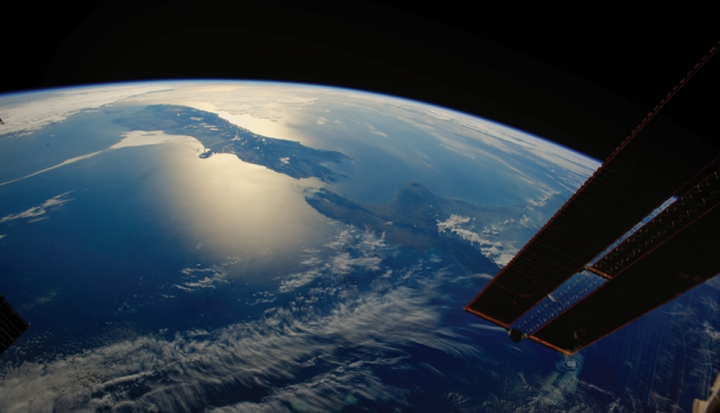Two documentaries currently trending on Netflix take a look at the planet from decidedly oppositional perspectives—and they might change how you think about the ground you stand on.
Behind the Curve is a new documentary (November 2018) by Daniel J. Clark about Flat Earthers—people who believe, against all human knowledge and scientific proof, that the Earth is flat. Some of them imagine the Earth as a Frisbee-like disc. Others think it’s like a cheese plate, covered with a transparent dome. There is, of course, no evidence supporting either model, but Flat Earthers don’t require evidence.
Instead, they value personal experience.
As they walk around the neighborhood, things appear to be flat, and that is good enough for them. They don’t trust scientists. They don’t like one another much, either, feuding between Frisbee and cheese dome factions and mounting YouTube-fueled accusations that some among them are CIA plants or NASA spies.
Flat Earthers accuse an amorphous “they” of spreading ideas about the Earth being round, though Flat Earthers can offer no reason anyone would do such a thing and cannot name who “they” is. This also confounds viewers: What could possibly be the motivation of any group to sell centuries of civilization on an inaccurate view of the shape of the world and the nature of the cosmos? In one of the more disturbing moments of the film, one Flat Earther suggests “they” might be Jews or Muslims. She also states that she would believe in the Boston Marathon bombing only if her own leg had been blown off there, dismissing the lived experience of the people standing on the streets of Boston that day and the three dead, hundreds injured, and 16 victims who lost their limbs. She is perfectly willing to do that.
Why? That’s the film’s deeper message: why humans might work so hard to believe things that are patently ridiculous. Clark includes interviews with physicists, astrophysicists, an astronaut, and, wisely, psychiatrists. They all wrestle with understanding beliefs that defy every observable condition around them and demand the rejection of science, facts, physics, astrophysics, and education. The power of community, some researchers say, may work to keep like-minded individuals cemented to a cause—even a ridiculous cause that is easily proved groundless. If they changed their minds, they would lose their friends, their sense of self-importance, and their uniqueness. One Flat Earther says that believing the world is flat helps him feel like he’s not a meaningless speck in a gigantic universe. Instead, he’s a speck on an oversized Frisbee, which is, apparently, comforting.
The scientists in the film remind us that skeptics test hypotheses and seek the truth. Flat Earthers are in denial, unwilling to consider impartial evidence lest their position be challenged. In the film, two Flat Earther-designed experiments end up proving the Earth is curved. The conclusion? The experiments failed. The Earth is still flat.
Thinking that so adamantly circumvents facts is puzzling and sometimes even amusing, but it becomes less amusing when it is practiced by elected officials, voters, and leaders. Magical thinking that resists reality can result in ill-informed decision-making that affects not only those who believe the Earth is flat, but all those who dwell upon it. And that’s not good for any of us.
Looking at Earth through the eyes of astronauts in space, the National Geographic documentary series One Strange Rock (produced by Darren Aronofsky, 2018) explores the formations, creatures, structures, and properties of Earth with cinematography so uncommonly stunning, it’ll knock your socks off. Along with being one strange rock, this is one breathtakingly beautiful planet. Will Smith narrates 11 episodes with humor and kid-friendly, accessible language, and eight astronauts share their wonder, delight, fear—and faith. If floating above the planet in a space station doesn’t turn one’s thoughts to a greater Being, what would?
The series’ final episode highlights astronaut Peggy Whitson, who spent more time in space—665 days—than any other astronaut. Charming scenes of her aging parents in their Iowa farmhouse cut to her mother and father walking out into the farmyard on a starry night to watch what looks like a shooting star—their daughter, streaking across the sky.
The film smartly makes use of many cultures and continents on the planet, embracing and reflecting multifarious ways of looking at life and interpreting the globe. (And it is round, by the way.)
The eight astronauts and numerous scientists in this film are fun to listen to and fascinating to watch, and their excitement about how the Earth works is a kind of combustible wonder that can only encourage young viewers to look to the stars and also try harder in math class. I had a biology professor in college who once stopped during a lecture on DNA to wonder at the intricate mechanics of cellular biology with a tear in his eye: “How is science not faith? Everything I learn through science only makes me feel more awestruck at the creation of it all,” he told the class.
There is a kind of belief that honors and delights in the realities of the world. That sees scientific enquiry as an appreciative unlocking of enigmas. That finds reverence in the unfolding of mysteries and the discovery of knowledge.
The enduring lesson of One Strange Rock is that word, one. Whitson says her home is not “Iowa” or the “United States” but “Planet Earth.” Looking at it from space, our interdependence and our fragility is obvious. We have to take care of our ecosystem and one another.
This article also appears in the June 2019 issue of U.S. Catholic (Vol. 84, No. 6, pages 38–39).
Image: Courtesy of NASA













Add comment